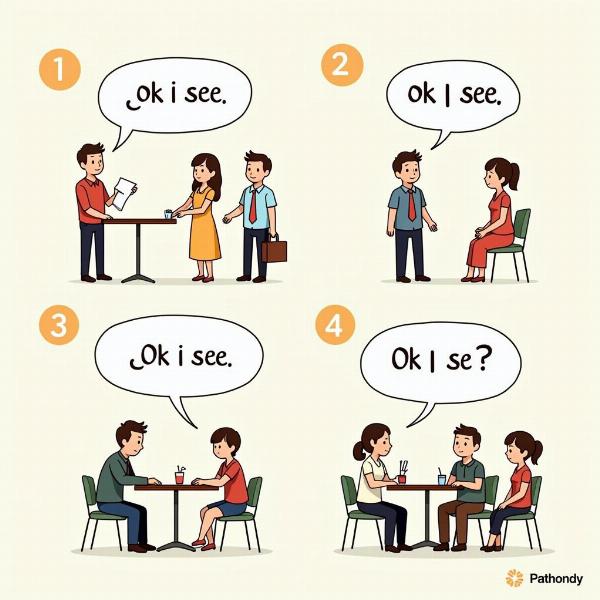“Ok I See” is a common English phrase, and understanding its meaning in Hindi can be helpful for anyone navigating cross-cultural conversations. While there isn’t one perfect Hindi translation that captures all the nuances of “Ok I See,” this article explores various Hindi equivalents, their contexts, and how to use them effectively. “Ok I See” often conveys understanding and acknowledgement, and choosing the right Hindi equivalent depends on the specific situation.
Different Ways to Say “Ok I See” in Hindi
“Ok I See” can express simple acknowledgement, understanding, or even a hint of agreement. Depending on the context, several Hindi phrases can effectively convey its meaning.
- ठीक है, मैं समझ गया/गई (Theek hai, main samajh gaya/gayi): This is a fairly direct translation meaning “Okay, I understood.” It’s suitable for most situations and is generally considered polite and respectful. Use gaya if you are male and gayi if you are female.
- अच्छा, ठीक है (Achha, theek hai): This translates to “Good, okay,” and carries a slightly more casual tone. It’s appropriate for informal conversations.
- समझ गया/गई (Samajh gaya/gayi): Simply “Understood,” this is a more concise option for casual conversations where brevity is preferred. Again, remember the gender distinction.
- हूँ, समझ गया/गई (Hmm, samajh gaya/gayi): Adding “Hmm” before “understood” adds a thoughtful tone, suggesting you’ve processed the information.
- कोई बात नहीं (Koi baat nahi): This phrase usually translates to “no problem” but can also convey understanding in certain contexts, especially when responding to an explanation or apology.
Choosing the Right Phrase
Selecting the appropriate Hindi translation depends largely on the formality of the situation and your relationship with the other person. For business interactions or conversations with elders, using “Theek hai, main samajh gaya/gayi” is generally the safest bet. In more relaxed settings with friends or family, “Samajh gaya/gayi” or “Achcha, theek hai” might be more fitting.
Common Scenarios and Usage
Consider these examples:
- Formal: Your boss explains a new project. You respond, “Theek hai, main samajh gayi” (if you’re a woman) to show you understand the instructions.
- Informal: Your friend tells you about their weekend plans. “Achha, theek hai” is a suitable response.
- Casual: Your sibling reminds you about a chore. A simple “Samajh gaya” is sufficient.
 Using "Ok I See" in Hindi Conversations
Using "Ok I See" in Hindi Conversations
Beyond the Basics: Expressing Deeper Understanding
Sometimes, “Ok I See” can imply more than just basic comprehension. It can indicate a deeper understanding of the implications or consequences of something. In such cases, you might add phrases like:
- मुझे पूरी बात समझ आ गई (Mujhe puri baat samajh aa gayi): “I understand the whole thing/situation.”
- मैं अब समझता/समझती हूँ (Main ab samajhta/samajhti hun): “I understand now.” This implies a previous lack of understanding that has now been resolved.
Conclusion
Mastering different ways to express “Ok I See” in Hindi can significantly enhance your communication skills in cross-cultural settings. By choosing the appropriate phrase based on context and nuance, you can convey understanding, acknowledgement, and build stronger connections. Remember to consider the level of formality and your relationship with the other person when selecting the best translation. “Ok I See” meaning in Hindi isn’t just about literal translation, it’s about capturing the essence of the phrase and using it effectively.
FAQ
- What is the most common way to say “Ok I See” in Hindi? Theek hai, main samajh gaya/gayi is the most common and versatile option.
- Can I use Samajh gaya/gayi in formal settings? While acceptable in some cases, it’s generally better to use a more formal phrase like Theek hai, main samajh gaya/gayi in professional or respectful contexts.
- Is there a difference between Achha and Theek hai? Both mean “okay,” but Achha carries a slightly more casual tone.
- How do I express deeper understanding than just basic comprehension? Consider using phrases like Mujhe puri baat samajh aa gayi or Main ab samajhta/samajhti hun.
- What should I consider when choosing the right Hindi phrase? The level of formality, your relationship with the other person, and the specific nuance you want to convey are all important factors.
Related Articles
- hindi meaning of preening
- geela meaning in hindi
- what do you want to become meaning in hindi
- dreary desert meaning in hindi
Meaning-Hindi.in is your trusted partner for professional Hindi translation services. We specialize in business, legal, technical, website, academic, and specialized translations, offering fast and accurate services to meet your diverse needs. Our expertise spans various industries, ensuring culturally sensitive and contextually accurate translations. Contact us today for your Hindi translation requirements at email: [email protected] or phone: +91 11-4502-7584. Meaning-Hindi.in is dedicated to bridging language barriers and fostering clear communication.